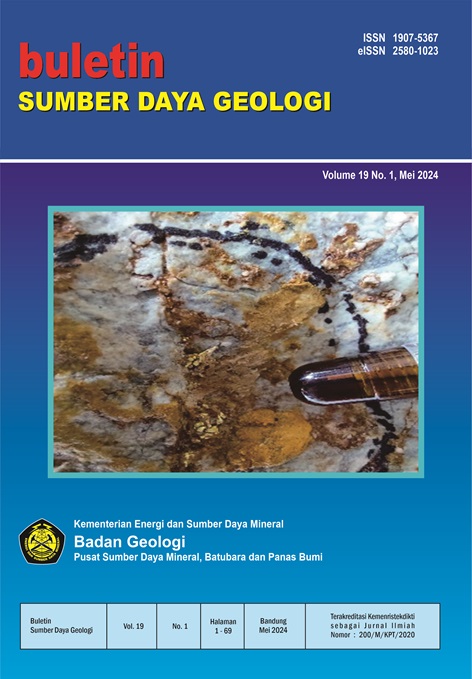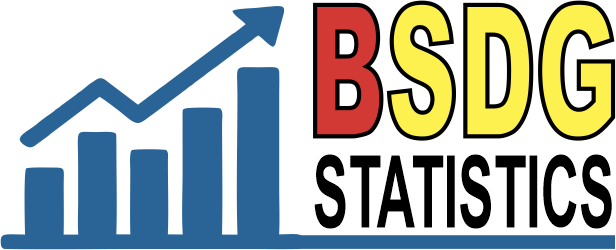SEBARAN UNSUR DAN ASOSIASI UNSUR Fe LATERIT BESI DAERAH BLOK X, PT SILO, PULAU SEBUKU, KALIMANTAN SELATAN
ELEMENTAL DISTRIBUTION ANALYSIS AND ELEMENTAL ASSOCIATION OF Fe LATERITC IRON, BLOCK X AREA, PT SILO, SEBUKU ISLAND, SOUTH KALIMANTAN
Abstract
The study area is located in Blok X, PT SILO, Sebuku Island, South Kalimantan. The geology of the study area is dominated by serpentinized ultramafic rocks, which have a high potential for the formation of lateritic iron minerals. The aim of the investigation of the area was to determine the vertical and horizontal distribution of the element contents and the association of the iron elements. Drilling, sample analyses using XRF, petrography and statistical analyses of correlation matrices and dendrograms were carried out. Fe, Ni, P, Co, Si, Mg, Cr, Al, Mn, Ca, Na, K and Ti were analyzed in 5.150 samples using the XRF method. The high iron content is found in the red limonite zone with 40-55% and in the yellow limonite zone with 40-52%. The lithology of the area with high iron content is ophiolitic ultramafic rock. In the vertical distribution profile, the high iron content is also found in the red limonite - yellow limonite zone. Based on the dendrogram analysis and the correlation matrix, the correlation of the Fe elements in the study area shows that the Fe elements are strongly correlated with the Co, Cr and Mn elements and generally with the Ni elements. Elemental iron is strongly negatively correlated with the elements Si and Mg.
Downloads
References
Ahmad, W. 2008. Nickel Laterites: Fundamental of Chemistry, Mineralogy, Weathering Processes, Formation, and Exploration, VALE Inco-VITSL (Tidak diterbitkan).
Barnes I, O’Neil JR. 1969. The relationships between fluids in some freshalpine-type ultramafics and possible serpentinization, WesternUnited States. Geol Soc Bull 80:1947–196.
Divisi Eksplorasi dan Geology Development. PT Sebuku Iron Lateritic Ores. 2013. Laporan Pemetaan Geologi Pulau Sebuku, Kalimantan Selatan. (Tidak diterbitkan).
Hernandi, D., Haryanto,D.A., Rosana, F.M. 2017. Domain Geologi Sebagai Dasar Pemodelan Estimasi Sumber Daya Nikel Laterit Perbukitan Zahwah, Sorowako, Kabupaten Luwu Timur, Provinsi Sulawesi Selatan.
Morgan, P.J., Ranero, R.C. 2023. Roles of Serpentinization in Plate Tectonics and the Evolution of Earth’s Mantle. https://www.researchgate.net/publication/. Diunduh tanggal 29 maret 2024.
Pinti, L.D. (2011). Serpentinization. https://www.researchgate.net/publication/259562269_Serpentinization/
Diunduh tanggal 17 maret 2024.
Rustandi, E., Nila, E. S., Sanyoto, P., dan Margono, V. (1995). Peta Geologi Lembar Kotabaru, Kalimantan Skala 1 : 250.000. Pusat Penelitian dan Pengembangan Geologi: Bandung.
Setyanta, B., Setiadi, I. 2006. Kompleks Batuan Ultramafik Meratus Sebagai Bagian Dari Ofiolit Kerak Samudera Ditinjau Dari Aspek Geomagnetik Dan Gaya Berat.
Soesilo, J., Schenk, V., Suparka, E., Abdullah, I.C. 2015. The Mesozoic Tectonic Setting Of SE Sundaland Based On Metamorphic Evolution.
Sugiono. 2018. Metode Penelitian Kuantitatif, Kualitatif D dan R. https://opac.perpusnas.go.id/ Diunduh 17 Maret 2004.
Copyright (c) 2024 Buletin Sumber Daya Geologi

This work is licensed under a Creative Commons Attribution-NonCommercial-ShareAlike 4.0 International License.
Authors whose manuscripts are published agree to the following terms:
The publication rights of all journal manuscript materials published on the Buletin Sumber Daya Geologi website are held by the editorial board with the knowledge of the author (moral rights remain with the manuscript’s author).
The formal legal provisions for access to digital articles in this electronic journal are subject to the terms of the Creative Commons Attribution-ShareAlike (CC BY-SA) license. This means that Buletin Sumber Daya Geologi has the right to store, convert media/formats, manage in the form of a database, maintain, and publish the article without requesting permission from the author, as long as the author’s name is cited as the copyright holder.
Manuscripts published in both print and electronic formats are open access for educational, research, investigative, and library purposes. Beyond these purposes, the editorial board is not responsible for any violations of copyright law.















